-
Posts
3,370 -
Joined
-
Last visited
-
Days Won
22
Everything posted by bitflipper
-

Exc!te Cymbal Is A FREE Ultra-Realistic Physically-Modeled Cymbal Plugin
bitflipper replied to satya's topic in Deals
Yeh, it does sound surprisingly good. I might actually use this. Odd it doesn't include a volume control. That's going to make it difficult to integrate into a kit. No, the $20 Pro version doesn't have one, either. All the parameters are automatable, though, so you could make it simulate different cymbals on the fly. -
I get most of mine from Sweetwater, but only because I am lazy and a creature of habit. They're expensive - my local music store is cheaper - but the quality is good. Never had one fail. But those prices at Seismic Audio are good enough that I could afford to buy spares, making it seem like a safe gamble. At the moment I have two critical cables in my gig bag that have no backups (25' TRS to XLR, keyboard to QSC K10.2s), so I'm thinking I might pick up a couple spares since they're only $17 each. Thanks for the tip!
-
Bzzzt! Wrong. The correct answer is "Why Don't We Do It In the Road".
-
I was doing great up until the half-second samples. I was surprised that I got any of those. l was hoping for some easier clues, like the opening chord to Hard Day's Night. But no, he had to throw in Julia. Well, at least he didn't include "Run Like a Shadow".
-
You won't regret it. I initially thought the Fiddle was just a one-off novelty. It isn't! To my surprise, it's proven useful in genres beyond bluegrass, including classical orchestration where you'd layer a solo violin over a violin ensemble for melodic definition. Loved Merry Maggie, btw. The Fiddle would fit right into that one.
-
OK, Beatles experts, you think you're so smart - try this one:
-

cakewalk: How we got here from there
bitflipper replied to Robert Hale's topic in Cakewalk by BandLab
Sadly, 30 years ago you either couldn't afford the stuff you have today, or it didn't exist yet. 40 years ago I desperately wanted an Oberheim 8-voice, but it cost as much as a new car. Today a faithful recreation of that instrument sits on my hard drive and cost me, iirc, less than 50 bucks. Back then I was gigging with an electronic piano (Roland EP-30) that only kinda sorta sounded vaguely like a piano. Today I have dozens of pianos on tap, including multiple Steinways and Yamahas, both on disk and in hardware synths. There's never been a better time to be a music-maker than now. -
You know how they put all that useless crap on display in the checkout line at the supermarket? They're hoping you'll make a dumb impulse buy just because you're bored waiting in line. Ooh, a flashlight that's also a keychain! I could use that. And it's only $7.99! Well, today I was using DDMF's Plugin Doctor when it popped up with a notice that an update was available. So I popped over to their site and found myself at their own impulse-buy rack. I saw a product called ChordDetector. Ooh, that could be handy. And it's only $15! The idea is that you play a wav or mp3 and it shows you the chord progression. Sounds reasonable. I mean, Melodyne can do that, right? A potential timesaver at band practice. Problem is, this thing just flat doesn't work. I gave it simpler stuff to analyze, such as an unaffected acoustic guitar file. It made no difference. C | Bbm | E | Bbmaj7 | C#m | Gm just ain't a thing. Not in my universe, anyway. And that was my own composition, so I knew the chord progression was Em | G | D. I feel like I just got home from the supermarket, proud owner of a flashlight that's also a keychain. One that doesn't light up and won't hold keys.
-
AKA the first annual "Please Come Back, We're Sorry and Won't do it Again" sale.
-
RE: Bruno Youtube says it's turning the audio down by 48%, and that the original had a loudness of 5.6dB. That's not -5.6dB, but +5.6dB, meaning 5.6 dB louder than their preferred target. Contrast with this video, which YouTube did not turn down. Listen to the crispness of the drums and guitars, and the clarity of the vocals.
-
That's how I'd do it. If you want to make it permanent and get rid of the plugin, freeze / bounce with fx applied. Channel Tools can also adjust the relative volume of left and right, if that's the main objective.
-
Clever workaround! I wouldn't have thought of that. I've made no secret of being an Indiginus fanboy, but have to admit the articulations are limited. But for budget $59 instruments it's to be expected that there might be some limitations. But for just 20 bucks more, have a look at the Slide Lap Steel from Orange Tree Samples. It makes it easy to bend up to a target note. Even when playing more than one note you can make each note conform to the scale. Both it and the Slide Acoustic, which has the same capabilities, are currently on sale as a bundle for $129.
-
I normally greet all dynamics processors with a big yawn and treat claims that any of them does anything magical with great skepticism. I long ago settled on a couple compressors for everything and haven't ever wished there was something better. But I gotta admit this one's piqued my curiosity. Seems this would be best suited for the master bus, since it's only in the context of full-range material that LUFS makes sense as a leveling reference. I can't imagine, for example, that it would be particularly useful on a vocal or bass track. Only one way to find out: I've downloaded the demo. Kudos to Aaron for offering a 30-day uncrippled demo. I have a question for Aaron - what's the music used in the demo video? I like it.
-
Just add random pitch and tempo modulation to your finished track. It will be original. Nobody will want to listen to it, but it will be original.
-
So it's a multi-band exciter? (um, sorry, "harmonic processor"). Ed, you need help.
-

Zero G ?Weekend Offer! 50% OFF Phaedra + Epica Redux!
bitflipper replied to cclarry's topic in Deals
I don't normally buy sampled synths - after all, cajoling your favorite synth into making a sound you hear in your head is half the fun. But for $27.50, hmm. And like the old joke goes, with 17,000 presets there's gotta be a pony in there somewhere. -
You win, Bovinator. Tightest wad of all time, I think. (Now watch Larry come along and claim he paid $0.50 for it using discount code IAMACHEAPSOB.)
-
It's standard practice across the entire software (and hardware) industry to keep new versions under wraps until they're officially released. Companies will tell you it's about protecting proprietary advantage, but it's really the same reason a band's rehearsals aren't public - you want to show the world the finished product, not how the sausage is made.
-
It's about time a jury ruled correctly on one of these cases. Ever notice that none of these cases have ever been brought by the presumed aggrieved party? They are always filed by either freeloading relatives of a deceased artist or by a legal firm retained by Warner or Sony. Except for The E*****. D** H****** is a litigious jerk. (Redacted so I don't get sued.)
-
Not me. However, there is some validity to the concept of LRC panning. The main message is you shouldn't be afraid to be aggressive in your panorama. A 10% adjustment may sound great while you're mixing, especially if you're using headphones. But out in the car or on your living room hi-fi it's going to be too subtle to hear. Instead of a nice wide mix it's semi-mono mush. I prefer a modified LRC approach, which is to place almost everything into one of 5 positions: L100, L50, C, R50 and R100. Footnote: people recommending LRC are assuming all your tracks are mono. While mono tracks are easier to mix and make for wider-sounding mixes, in practice you're probably going to have to work in some stereo tracks as well. That can be especially challenging if you're creating music entirely from synths and samplers, which all too often insist on being stereo, dammit!. A mix made from all stereo tracks can counter-intuitively sound more like wide mono if you don't handle panning properly. Fortunately, Cakewalk comes with a tool for panning stereo properly called Channel Tools. Even better, grab the panner from Boz Digital Labs.







